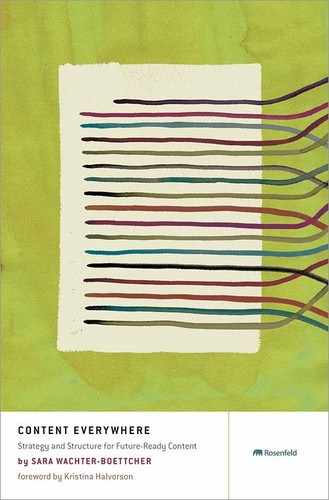HOW TO USE THIS BOOK
Who Should Read This Book?
This book is for anyone who cares about content and is interested in making it work for mobile devices, across multiple channels, and for an increasingly unfixed future.
You might consider yourself a content strategist, as I do. If so, as you strive for content that’s useful, meaningful, and sustainable, this book will help you think about all the places that content might go: desktop computers, yes, but also mobile devices, read-later applications, social media platforms, and myriad other places we haven’t even thought about yet.
Or, you might be an information architect or user experience designer tasked with structuring websites and designing navigation systems. In addition to designing macro systems for information, this book will show you how to construct more micro systems: structures within a single piece of content that allow you to do much more with it, from creating deep connections within a single site to building multiple products off the same core base of content.
If you’re a writer or editor, this book is designed to get you thinking less about pages of content and where they’ll “live” on a website, and more about the components that lend your content life. When you do, you’ll discover that the best way to keep the story, message, or meaning of your content intact isn’t to try to control how it looks on the page; it’s to give it the underlying structure that will let it be styled and used in appropriate ways wherever it goes.
You might also be a content manager wrangling a big CMS. An SEO specialist. A mobile designer or developer who’s trying to make your creations work with real content. Whatever your background or job title, if you want content that can go more places, more easily, then this book was written just for you. I hope you enjoy it.
What’s in This Book?
A couple hundred pages of ideas, models, concepts, tips, and a bunch of stories about people trying new ways to make their content work harder.
Practically speaking, though, this book is divided into four parts:
Part I explores the problems with content that is fixed and inflexible, and talks about how we can start looking at the content we create differently. It also defines how four key disciplines set a foundation for today’s challenge: content strategy, information architecture, technical communications, and content management.
Part II is all about building a framework: a way of breaking content down, building it up in meaningful models, and understanding what’s at play as it starts being used and reconfigured using everything from markup to media queries to APIs.
Part III digs into a few of the myriad things you can do with your content once you’ve sorted out how it’s structured and stored: make content more findable and interconnected, make it work harder on responsive and adaptive sites, reuse it across multiple products and personalized experiences, and prepare it to even leave your control completely.
Part IV will leave you with a call to get started—not just with structuring your content, but with changing your organization and its relationship to content, too. With these skills, you can create content that’s audience-centric, lively, and lovable—even as it is replicated and reused.
What Comes with This Book?
This book’s companion website (![]() rosenfeldmedia.com/books/content-everywhere/) contains some templates, discussion, and additional content. The book’s diagrams and other illustrations are available under a Creative Commons license (when possible) for you to download and include in your own presentations. You can find these on Flickr at
rosenfeldmedia.com/books/content-everywhere/) contains some templates, discussion, and additional content. The book’s diagrams and other illustrations are available under a Creative Commons license (when possible) for you to download and include in your own presentations. You can find these on Flickr at ![]() www.flickr.com/photos/rosenfeldmedia/sets/.
www.flickr.com/photos/rosenfeldmedia/sets/.
